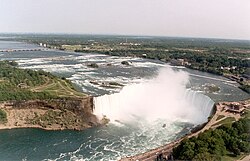This article needs additional citations for verification. (December 2015) |

In geomorphology, a knickpoint or nickpoint is part of a river or channel where there is a sharp change in channel bed slope, such as a waterfall or lake. Knickpoints reflect different conditions and processes on the river, often caused by previous erosion due to glaciation or variance in lithology. In the cycle of erosion model, knickpoints advance one cycle upstream, or inland, replacing an older cycle.[1] A knickpoint that occurs at the head (furthest upstream extent) of a channel is called a headcut.[2] Headcuts resulting in headward erosion are hallmarks of unstable expanding drainage features such as actively eroding gullies.[3]
Knickpoints also occur on other planetary bodies that previously had or currently have surface liquids, namely Mars[4] and Titan.[5] On Mars, the knickpoints have a common elevation that suggest a common sea level for a former Martian ocean.[4] On Titan, mountain valleys adjacent to the present-day hydrocarbon seas show evidence of knickpoints and recent sea-level change.[5]
- ^ Tinkler, Keith J. (2004). "Knickpoint". In Goudie, A.S. (ed.). Encyclopedia of Geomorphology. pp. 595–596.
- ^ Bierman, Paul; Montgomery, David (2013). Key Concepts in Geomorphology.
- ^ Knighton, David (1998). Fluvial Forms and Processes, A New Perspective.
- ^ a b Duran, Sergio; Coulthard, Tom J.; Baynes, Edwin R. C. (2019-10-22). "Knickpoints in Martian channels indicate past ocean levels". Scientific Reports. 9 (1): 15153. Bibcode:2019NatSR...915153D. doi:10.1038/s41598-019-51574-2. ISSN 2045-2322. PMC 6805925. PMID 31641171.
- ^ a b Lucas, Antoine; Aharonson, Oded; Deledalle, Charles; Hayes, Alexander G.; Kirk, Randolph; Howington-Kraus, Elpitha (2014). "Insights into Titan's geology and hydrology based on enhanced image processing of Cassini RADAR data". Journal of Geophysical Research: Planets. 119 (10): 2149–2166. Bibcode:2014JGRE..119.2149L. doi:10.1002/2013JE004584. ISSN 2169-9100.